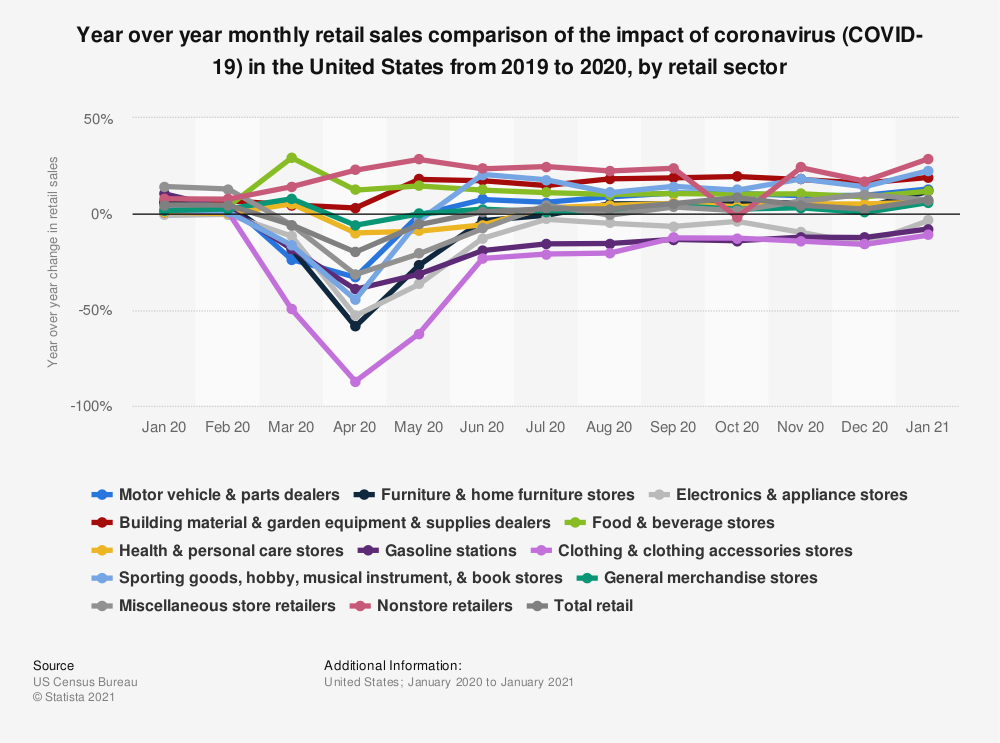I feel like I’m of the lucky ones.
My job is about writing for a company that sells a product online. I can do that from home. Even in an economic crash instance, I could find something to do online to make ends meet.
During the quarantine period, I haven’t stopped working. I continued getting my salary, paying my bills, and taking care of myself.
Yet, some people are not that lucky.
I’ll stop you right here.
This article has nothing sentimental about it. It’s about only one thing: Making a Brick-and-Mortar business thrive in a post-Coronavirus world.
We’ll take a look at where brick-and-mortar business owners should start and how to take a physical store online.
We’ve published another article, last month, about the 4 Things all businesses should do amid the Coronavirus. I think you should also check it out.
Let’s get into it.
The impact of COVID-19
I think that apart from the travel industry, retail was hit the hardest by the pandemic.
People started buying only for their daily needs. We all remember the toilet paper hoarders.
Let’s see a monthly retail sales comparison of the impact of Coronavirus in the United States.

Find more statistics at Statista
“Department stores and clothing stores are facing an extinction-level event after having experienced years of decline.”
The more sales dropped, the more businesses started laying people off, which results in more empty pockets, which leads to even fewer sales, which also results in more empty pockets. It’s the snake that eats its own tail.
But are things that terrible?
The situation is dark, but there are things that we can do. This pandemic didn’t drop brick-and-mortar sales; this is just a symptom. The truth is that the consumers changed the way they shop.
It surely is a misstep for your business, but you can also change the way you sell your inventory.
The 1st thing you can do today.
The truth is that when I was researching for this article, I stumbled upon the term “Dark store.”
Of course, I was intrigued.
Then I got disappointed because I knew what the term refers to, but I didn’t realize there was a name for it.
So, a Dark store is a retail outlet or distribution center that caters exclusively for online shopping.
Although the model was popular with grocery stores, due to the events of the COVID-19 outbreak, other businesses starting adopting it, as well.
Brick-and-mortar retail stores are being converted to fulfillment centers, adopting a “ship-from-store” program.
Bed&Bath closed all its stores at the beginning of the crisis, but after seeing an 85% increase in online orders, the reopened 25% of the stores as fulfillment centers.
So what should you do? Open a dark store?
The 1st thing you should do is two things:
- Convert your regular store into a dark store.
- Start selling online.
I know it sounds like a lot of work, and it is. But it’s something that might save the business- and create possibilities for the future.
I don’t know anything about the process of turning a retail store to a dark store. The legal requirements may vary from state to state or from country to country. It’s wise to ask someone to help you with that, a lawyer probably.
In the meantime, you should be preparing to start selling online.
Taking a brick-and-mortar business online.
This is short of a technical part.
You can either try to do it yourself or hire someone for the job. The latter is going to cost you, but you’ll save a lot of time.
Overall, here’s how you can take your brick-and-mortar store online in 5 steps:
- Buy a domain.
- Run a prelaunch campaign.
- Build your eCommerce store.
- Launch!
- Sell.
Buy a domain.
This step is rather obvious. Your online store needs a domain name. You can buy one by using a service like GoDaddy or Hostinger.
All you have to do is to find a reliable domain registrar, search for a preferred domain name, buy it, and register it.
I’m not going to into the exact details on how to perform those steps. For that, you can check Hostringer’s “How to Buy a Domain Name – A Simple Guide.” It’s the best resource I could find on buying a domain.
Running a prelaunch campaign.
If you’re a reader of our blog, you know that I’ve written numerous articles about the importance of prelaunch campaigns, and how to set them up.
The first thing you have to do is to build a “coming soon page.”

The example in the image above is also a great idea. It’s the subscription model.
If you have items in your inventory that you know people buy in a recurring way, you can bundle those items and make them part of your prelaunch campaign.
Nevertheless, if you need inspiration for your prelaunch landing page, I have 40 coming soon page examples. The article also included a short guide on how to build your own coming soon page.
The gist of the short guide; if you want to build a coming soon page, you need three tools:
- A landing page builder or a CMS.
- An Email Marketing platform.
- A Referral Marketing software.
The landing page’s role is to describe what’s coming up from your store and capture emails.
That’s it.
You can provide incentives to people to get them to subscribe or refer their friends. That’s where Viral Loops might come in hand.
To make Viral Loops easy to use, we created templates that will help you build the ideal campaign based on the way you want to reward people.
- Template for giving early access, inspired by Robinhood.
- Template for providing rewards, inspired by Harry’s.
Then, on the day you launch your eCommerce store, you’ll use an email marketing tool (like Mailchimp), to notify the prelaunch subscribers.
Building and launching an online store.
The first thing you need to do before start building your online store is deciding which eCommerce platform you’re going to use.
You can always hire someone to build you a custom CMS, but custom solutions bring custom problems. And custom problems are expensive.
If I were in your shoes, I would go with Shopify.
It’s probably the most popular option for eCommerce stores, which means that there’s a vast community, and a ton of information online.
There’s also a variety of Shopify apps that will make your life easier. Shopify offers a theme collection that will help you get started with the layout of your store, faster.

Your online store’s initial launch depends heavily on the prelaunch phase that I described in the previous section of this article.
Even if a prelaunch campaign is a great push, it can’t carry the weight of your entire plan. You have to make sure that when your online store launches, it will already be as optimized as possible.
First, you have to define your buyer persona. This process will help you identify your online message and the values that your customers appreciate and enjoy.
Then on the more technical side, you have to:
- Optimize your store’s SEO.
- Start using social media.
- Produce relevant content.
- Create a list building mechanism.
- Run ads.
- Drive sales via referrals.
I’ve covered everything you need to know about driving traffic to a Shopify store, in a previous article. Make sure to give it a look.
An interesting approach would be to combine list building with referral marketing and Facebook ads.
By splitting all audiences in their dedicated adset and running personalized campaigns, you can reduce your Facebook CPL (Cost Per Lead) by a significant percentage.
When the Corona outbreak ends.
The impact of COVID-19 on the world economy is yet to be seen. Whatever happens, the crisis shaped consumer habits forever. Even if everything goes back to the way it was, making an opening to the online market, it would be inevitable for your brick-and-mortar business.
Even if your physical store opens its doors to the public, you should keep “pushing them” to buy from your online store.
e.g.
The cashier could register them to your eCommerce store and give them a discount for their next online order from you.
Before you go.
The outbreak of the Coronavirus dealt a significant amount of damage to the retail industry and kept brick-and-mortar businesses closed.
Consumer habits also changed, and online sales have gone up. It looks like the perfect time for a brick-and-mortar store to go online. This can be done in 3 steps:
- Convert the physical store to a dark store.
- Launch an eCommerce store.
- Use the dark store as an order fulfillment center.
Even after the outbreak ends, you can use your physical store to sell to people online. Your eCommerce store could be a cost-effective way to grow your business and a very convenient choice for your new and existing customers.
Apostle Mengoulis
Apostle is a core member of the founding team at Viral Loops. He has worked closely with hundreds of referral marketing campaigns made with Viral Loops. Apostle has years of experience in growing and marketing companies and co-founded Growth Hacking University.

